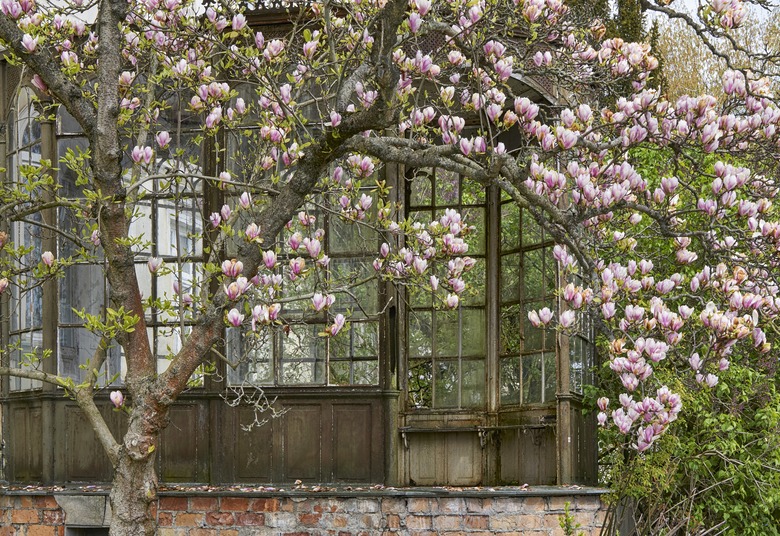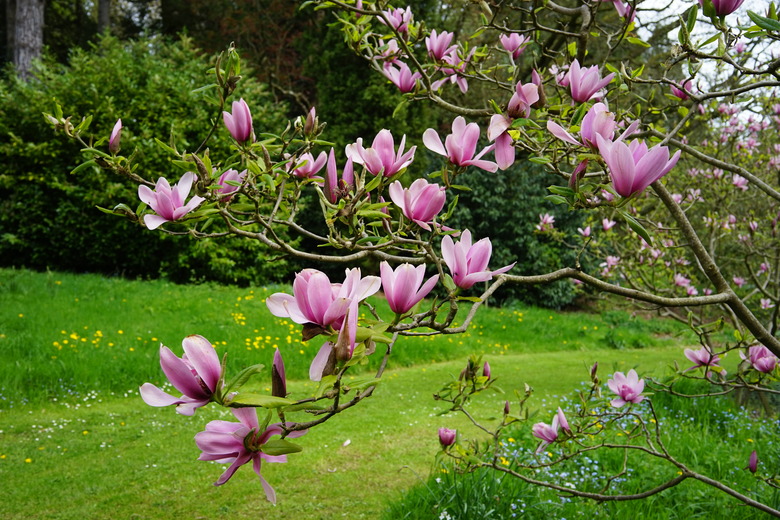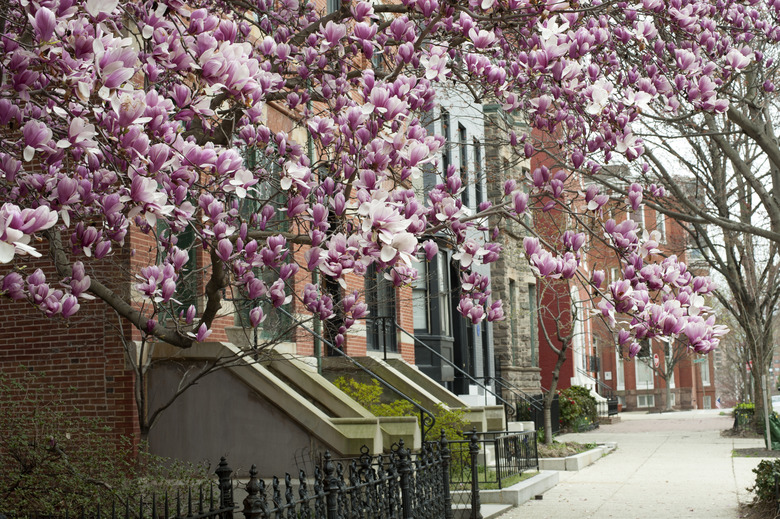A Beginner's Guide To Magnolia Shrubs And Trees
We may receive a commission on purchases made from links.
Magnolia (Magnolia spp.) trees and shrubs exemplify diversity in the botanical world. Populating the approximately 125 magnolia species are numerous cultivars and hybrids, which are typically characterized by their dramatic and fragrant flowers.
Depending on the species and cultivar, magnolias can be towering giants or small-landscape gems, evergreen or deciduous and adaptable to climates with hard freezes during harsh winters or balmy regions that barely dip below freezing. Choosing the perfect flowering magnolia can enhance your landscape design by adding form, color and fragrance for an aesthetic tour de force.
Magnolia Plant Characteristics
Magnolia Plant Characteristics
With such variety among magnolia species and cultivars, many individual attributes are unique to specific plants, but because all magnolias are in the same plant family (Magnoliaceae), they also share many common attributes. In fact, Palomar College notes that this plant family is in the botanical subclass (Magnoliidae) that includes the most primitive types of living angiosperm plants. Boiling down all the science, this means that magnolias are descended from plants that lived millions of years ago, which attests to their endurance.
Magnolia flowers are similar in appearance. Clemson Cooperative Extension describes these blooms as ranging in size from 3 inches to 12 inches in diameter, with petals that may be wide or thin and strap-shaped. Even though the blooms are commonly called "flowers," they're more correctly called "tepals," which are formed by the fusing of petals and sepals (modified leaves). Because magnolia flowers do not make true nectar, which attracts most pollinators, University of Florida IFAS Gardening Solutions notes that the blooms rely on a fragrant and sugary substance they secrete to attract beetles for pollination.
Southern Magnolia Species
Southern Magnolia Species
You'd be hard pressed to drive through an established residential area in the South without losing count of a particular type of magnolia tree you see. Southern magnolia (Magnolia grandiflora) is a perennial in U.S. Department of Agriculture (USDA) plant hardiness zones 7b through 9a, where it is a magnificent tree that rises to stately heights between 60 and 80 feet. As an evergreen magnolia, this tree has glossy, dark-green leaves that have brown, fuzzy undersides. The creamy-white fragrant flowers are huge, often reaching a diameter of 12 inches when they bloom in summer.
If a Southern magnolia this large would overwhelm your small landscape, there's another option for a smaller cultivar of this species. Little Gem magnolia (Magnolia grandiflora 'Little Gem,' USDA zones 7b through 8b). As the Georgia Gold Medal plant winner in the tree category for the year 2000, Little Gem has all the attributes of the species but in a compact package. It reaches a height of only 15 to 20 feet with a spread of 8 to 10 feet.
Star Magnolia Species
Star Magnolia Species
The Missouri Botanical Garden points to star magnolia (Magnolia stellata, USDA zones 4 through 8) as the first type of magnolia to begin blooming each year, with starburst-shaped white flowers opening as early as March, even before the leaves emerge. As a medium-sized shrub or small tree, star magnolia keeps a tidy and compact size of 15 to 20 feet tall and 10 to 15 feet wide. Each has 12 to 18 narrow tepals arranged close together to form the starburst shape.
The University of Connecticut lists cultivars of star magnolia, including Centennial (Magnolia stellata 'Centennial'), which is a longstanding industry standard for this magnolia species. Centennial's white flowers are tinged with pink. Another star magnolia cultivar, Royal Star (Magnolia stellata 'Royal Star') is slightly shorter, reaching a mature height of around 10 feet. Royal Star's white flowers open from pink buds a little later in spring.
Sweet Bay Magnolia Species
Sweet Bay Magnolia Species
Sweet bay magnolia (Magnolia virginiana, USDA zones 5 through 10), has 2- to 3-inch cup-shaped waxy flowers that typically open in May and June. The white blooms are sweetly scented with a hint of lemon. In cooler climates across its hardiness range, sweet bay magnolia generally grows 15 to 20 feet tall, but it can reach a height of 60 feet tall in warmer climates. So, the same plant can be grown as a large shrub in the North and as a tree in the South.
Sweet bay magnolia's leaves are lance-shaped — green on top with silvery undersides, which offers a lovely contrast when the wind blows. In the South, sweet bay magnolia may retain its leaves during winter, but it typically sheds its leaves in the North. The Missouri Botanical Garden notes a species characteristic that differs from other types of magnolias — sweet bay magnolia flourishes on wet, boggy soils, which makes it a good choice for rain gardens.
Cucumber Tree Magnolia
Cucumber Tree Magnolia
Cucumber tree (Magnolia acuminata, USDA zones 3 through 8) may not sound like a fitting name for a magnolia, but this plant's common name describes the appearance of its seedcones, which resemble warty cucumber fruits. These seedcones turn from green to red after the 2- to 4-inch greenish-yellow, cup-shaped flowers fade. You'll have to be patient to see a tree in bloom; it may be 12 years or more before the first flowers appear.
Most deciduous magnolias don't have particularly colorful leaves in autumn, but cucumber tree is an exception. Its leaves turn a pretty shade of golden yellow in autumn. Trees are half as wide as they are tall, reaching a mature height of 40 to 70 feet with a spread of 20 to 35 feet. Tree trunks on mature plants, which may measure 3 to 4 feet in diameter, have ridged, dark-brown bark.
Magnolia Hybrid Plants
Magnolia Hybrid Plants
When one magnolia species plant is crossed with another species plant or with a hybrid plant, the resulting plant is a hybrid (designated by an "x" in a plant's scientific name). Plant breeders develop hybrids to have the best traits from each parent plant, such as increased vigor and improved flower quality and color.
Saucer magnolia (Magnolia x soulangeana, USDA zones 4a through 9a) is one example of a hybrid magnolia. It's a deciduous tree with exquisite cup-shaped flowers that may be pink, lavender, purple or white, measuring 4 to 10 inches in diameter. The flowers burst into bloom in springtime before the leaves emerge. A saucer magnolia with bare branches that are covered with these flowers makes a dramatic impact statement in the landscape as a specimen plant. Saucer magnolia is a multitrunked plant that grows 15 to 30 feet tall and 15 to 25 feet wide.
The Little Girl series of magnolia hybrids includes eight plants: Magnolia x 'Jane,' 'Susan,' 'Judy,' 'Ann,' 'Betty,' 'Ricki,' 'Randy' and 'Pinkie,' hardy in USDA zones 4 through 8. These "girls" were bred by the U.S. National Arboretum and introduced in 1968, and their popularity has stood the test of time. Little Girls are deciduous magnolias that grow only 15 feet tall, with cup-shaped flowers in colors of pink to reddish-purple. Clemson Cooperative Extension lists 'Jane' as one of the most popular magnolias in this series, having fragrant, two-toned flowers that are white on the inside and reddish-purple on the outside. Because all the magnolias in the Little Girl series bloom later in spring than other deciduous magnolias, they often avoid being burned by a late spring frost.
Not to be outdone by the Little Girls, 'Jon Jon' magnolia (Magnolia x 'Jon Jon,' USDA zones 6b through 9a) was named by another "John" — John Allen Smith of Magnolia Nursery in Chunchula, Alabama — for a plant that was bred by Todd Gresham. As a deciduous magnolia, 'Jon Jon' has floral characteristics of saucer magnolia, but it blooms around two weeks later than most saucer magnolias. In warmer climates, flowers bloom in late February, and in cooler climates, they bloom in late March to early April. The mature height is 30 feet, but it may take a while to reach that height because this plant is slow-growing.
One plant you won't see on this list is tulip tree (Liriodendron tulipifera, USDA zones 4a through 9a), which has yellow flowers that look surprisingly like magnolia flowers even though the tulip-shaped foliage doesn't resemble magnolia leaves. The reason for the striking similarity to magnolia flowers on tulip tree is because both of these plants are related — "kissing cousins," if you will — with both being taxonomically classified in the Magnolia plant family.
Magnolia Care and Growing Tips
Magnolia Care and Growing Tips
With such a diverse spectrum of plants among magnolias, the care of individual species, hybrids and cultivars doesn't follow an exact cookie-cutter template. There are, however, general cultural guidelines that apply to most magnolias.
Full sun to partial shade promotes healthy growth and more abundant flowers on magnolias. In regions with hot summers, such as the deep South, many magnolias grow best when they receive shade or filtered sunlight in the afternoon.
Most magnolias respond best when grown on acidic soil with a pH of 5.5 to 6.5. Highly alkaline soils can prevent magnolia roots from being able to uptake certain nutrients, which causes nutrient deficiencies and may lead to yellowing leaves.
For most types of magnolia, moist but not soggy soil is best for the root systems. Because magnolias are usually shallow-rooted, applying mulch to a depth of 2 to 3 inches around the tree and extending mulch to the drip line helps keep soil moist. Fertile, well-draining soil that's high in organic matter, such as leaf compost, provides a favorable environment for the root systems to grow.
Deep and thorough waterings given infrequently are better for a magnolia than frequent, light sprinklings. For example, 1 inch of water each week (or twice weekly in hot weather) is better than running a sprinkler several times a week to barely moisten the soil surface. This is particularly important when magnolias are young, and the root systems are developing and fueling new growth.
Don't be too quick to start fertilizing a newly planted magnolia; wait until its root system takes hold and you see new top growth, which is usually the second year after planting. The University of Georgia Extension recommends a three-year fertilization regimen for a newly planted Southern magnolia, which also applies to other magnolia species. During the first growing season after you plant a magnolia and after you see new top growth, apply 1 cup of 10-10-10 or 8-8-8 fertilizer (or an organic equivalent) along the outer edges of the planting hole in March, May and July.
In the second year after planting, apply 2 cups of the same type of fertilizer in the soil area from the outer edges of the branches to 3 feet outside the outer edges in March, May and July. In the third year, apply 4 cups of the same type of fertilizer from the outer edges of the branches to 6 feet outside the outer edges in March, May and July. In the fourth year, most magnolia trees do not need supplemental fertilizer.
Magnolias require little or no pruning. The most you'll have to do is remove any damaged or dead branches. If you need to prune a magnolia to shape it, wait until after it has finished flowering. To help prevent the spread of disease pathogens, University of Florida IFAS Gardening Solutions recommends sanitizing all cutting tools by wiping with or dipping them in isopropyl alcohol or ethanol.
References
- Palomar College: The Magnolia Family (Magnoliaceae)
- Clemson Cooperative Extension: Magnolia
- University of Florida IFAS Gardening Solutions: Magnolias
- North Carolina State Extension: Magnolia grandiflora
- North Carolina State Extension: Magnolia grandiflora 'Little Gem'
- Missouri Botanical Garden: Magnolias
- Missouri Botanical Garden: Magnolia stellata
- University of Connecticut: Magnolia stellata
- Missouri Botanical Garden: Magnolia virginiana
- North Carolina State Extension: Magnolia x soulangeana
- Missouri Botanical Garden: Magnolia 'Jane'
- University of Florida IFAS Extension: 'Jon Jon' Magnolia – A Late-Flowering Deciduous Magnolia for Northern Florida
- Missouri Botanical Garden: Magnolia acuminata
- North Carolina State Extension: Liriodendron tulipifera
- University of Georgia Extension: Growing Southern Magnolia
- University of Florida IFAS Gardening Solutions: Disinfecting Your Garden Tools


